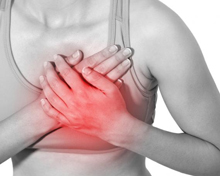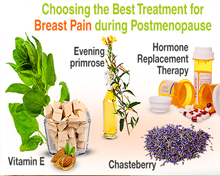Breast Pain
Breast Pain is Widespread Among Younger Women

Breast pain is a general complaint of younger women. Older women generally do not suffer from this pain. The pain can be in one breast or in both. It may not continuous but remain for one month and then subsides. Again it causes trouble to woman.
There are number of reasons for this pain. These include hormone changes during your period, water retention, which may happen during your period, injury to breast, pregnancy, Breast-feeding (nursing), and an infection in the breast.
Women may experience pain in their breasts many times. Lactating mother suffer from pain when their milk lets down. The letdown reflex is caused by the action of the hormone, oxytocin. Oxytocin stimulates the muscles of the breast to squeeze out milk. In the first few days after the birth, the hormone is released in response to baby suckling. Later on, when feeding baby, it can trigger this hormone release. Some mothers find that their breasts leak when this happens.
The letdown reflex feels different to different mothers. Some feel a slight tingling, some feel huge amounts of pressure and slight pain or discomfort and others feel nothing at all. Most mothers do not know about the letdown reflex in the early days of breastfeeding, although they may be aware of after pains (the pains experienced after birth as their womb contracts down to its pre-pregnancy size - which is caused by the same hormone). As time passes and breastfeeding becomes established, most mothers feel less pain.
 Women may experience severe pain when they produce excessive milk. Some women who produce great quantity of milk have painful twinges deep in the breast after feeds. Another reason for breast pain is that when yeast enters the milk ducts, (as a result of thrush) it can make breastfeeding painful.
Women may experience severe pain when they produce excessive milk. Some women who produce great quantity of milk have painful twinges deep in the breast after feeds. Another reason for breast pain is that when yeast enters the milk ducts, (as a result of thrush) it can make breastfeeding painful.
Thrush pain persists throughout the feed and is usually severe after feeds. However, thrush in the milk ducts is unusual. Engorgement can over-distend the milk-producing cells of the breast, making letdown difficult and sometimes painful. Mastitis or blocked ducts can cause an area of the breast to become red, sore, hard and inflamed. Other causes of breast pain are poor breast pump usage, a badly-fitting bra. Women must choose comfortable dresses.
Women should communicate all problems related to breast pain to their physicians. Physicians will assess the pain, taking into account the woman's personal history, family history, the area of pain, the intensity and duration of the pain, and the extent to which the pain interferes with her lifestyle. Physicians will also do clinical breast examinations, and if necessary, order additional breast imaging exams (such as mammography or ultrasound) to help determine whether the pain is related to another breast condition or possibly cancer. If no breast abnormality is indicated, the physician and woman should decide together whether drug treatment is will be effective.
Treatment
 Treatment for breast pain depends on causes. Doctor can converse about these treatments and choose one or more that give release to pain. Possible treatments for breast pain are wearing a support bra, taking an over-the-counter pain medicine. Women suffering from breast pain must avoid caffeine; use less salt, taking vitamin E or vitamin B6, Maintain an ideal weight, and nutritious diet.
Treatment for breast pain depends on causes. Doctor can converse about these treatments and choose one or more that give release to pain. Possible treatments for breast pain are wearing a support bra, taking an over-the-counter pain medicine. Women suffering from breast pain must avoid caffeine; use less salt, taking vitamin E or vitamin B6, Maintain an ideal weight, and nutritious diet.
Certain birth control pills may lessen breast pain. Patient must doctor if this therapy will work for her. If she has a breast infection, she will need antibiotics. She must consult doctor before taking any medicine. She must observe for signs of infection such as localized redness, nipple discharge, or fever. If she has these signs, she must immediately seek advice of medical doctor. In case of a breast injury, immediately apply a cold compress such as an ice pack (wrapped in a cloth but do not apply directly to the skin) for 15 to 20 minutes.
Articles on Health
- Causes and remedy for dark circles in females

- Harmful impact of mobile phone on unborn baby

- Maternal health care tips

- Rheumatoid Arthritis is Most Widespread in Female
- Periodontal ailment during Pregnancy
- Anemia is prevalent in Women
- Effect of Cell phone tower radiation on human health

- Current health scenario india
- Government health policies india
- Medical facilities india
- Hospital infrastructure india
- Shortage of Medical Professionals in India
- Quality standards indian hospitals
- Indian states health statistics
- Medical expenses india
- Hospitals in Ahmedabad
- Hospitals in Bangalore
- Hospitals in Chennai
- Hospitals in Cochin
- Hospitals in Delhi
- Hospitals in Hyderabad
- Hospitals in Kolkata
- Hospitals in Mumbai
- Hospitals in Pune
- Hospitals in Coimbatore
- Hospitals in Kochi
- Orthopaedics Hospitals in India
- Diabetology Hospitals in India
- Cardiology Hospitals in India
- Infertility Hospitals in India
- Neurology Hospitals in India
- Paediatrics Hospitals in India
- Nephrology Hospitals in India
- Oncology Hospitals in India
- Antiaging foods to improve skin

- Tips for Maintaining healthy bones
- Guidelines for preventing heart disease
- Tips to reduce eye strain while working on computer
- Mental health problems among elderly people
- Health problem of piles

- Health advices for air travel

- Dealing with Allergies
- Tips for Eyes Care
- Care for Crystal Clear Skin
- Tips For Healthy Hair
- Healthy Living is The Absolute Measure of Happiness
- Let Fragrance Rule Your Summer
- Most common vestibular disorder

- Osteoporosis Risk Factors
- Dengue

- Endocrine disorder

- Causes of liver damage
- Dry eye syndrome
- Kidney Stones
- Conjunctivitis: Irritating eye disease
- Anxiety Disorder
- Causes of Brain Damage
- Hepititis B
- Knowledge of Osteoarthritis
- Mental Illness
- Back Pain
- Sugar Addiction
- Diet Control Plans
- General Motors Diet Plan
- No Carbohydrate Diet
- One day Diet Plans
- Seven day diet Plans
- Vegetarian Diet
- Food for Health
- Genetically Modified Foods
- Healing Effects Of Fruits
- Vegetables That Heal
- Healing Effects Of Spices and Herbs
- Test your Stress Level
- Mantras for Relaxation & Stress free life
- Take walk For a healthy body and mind
- Squint is frequently observed in Children
- Consult-Doctor
- Free Handy Health Advice